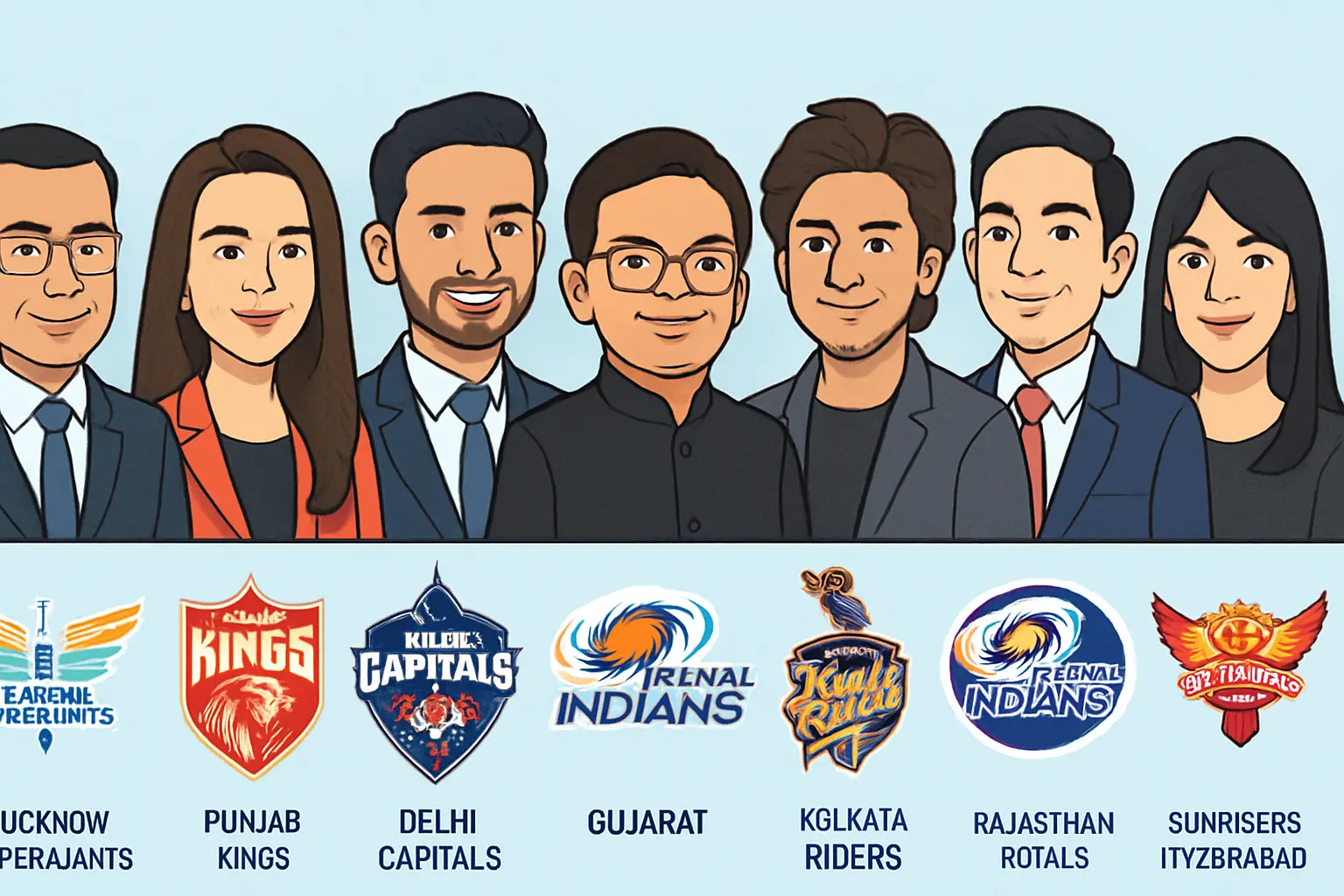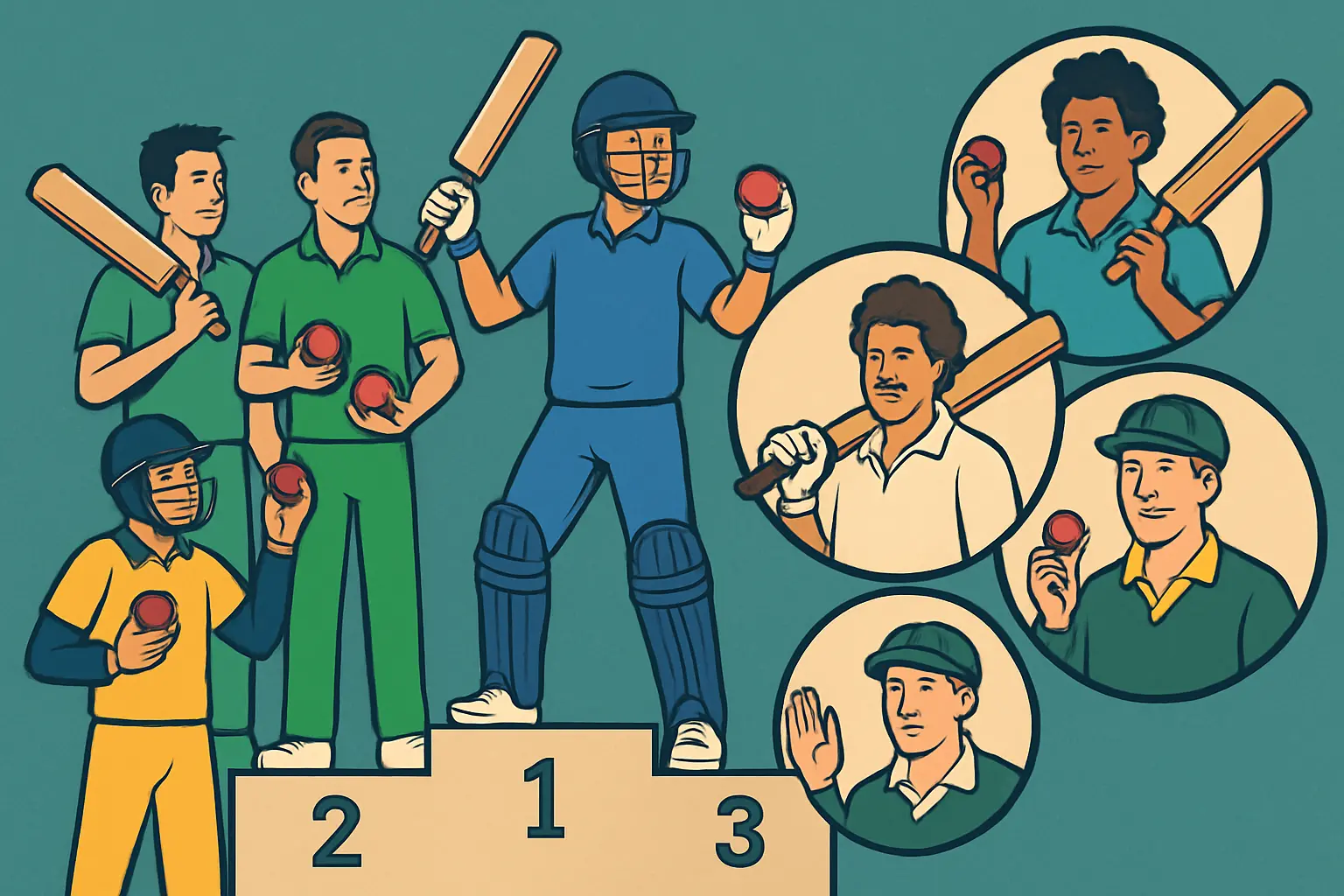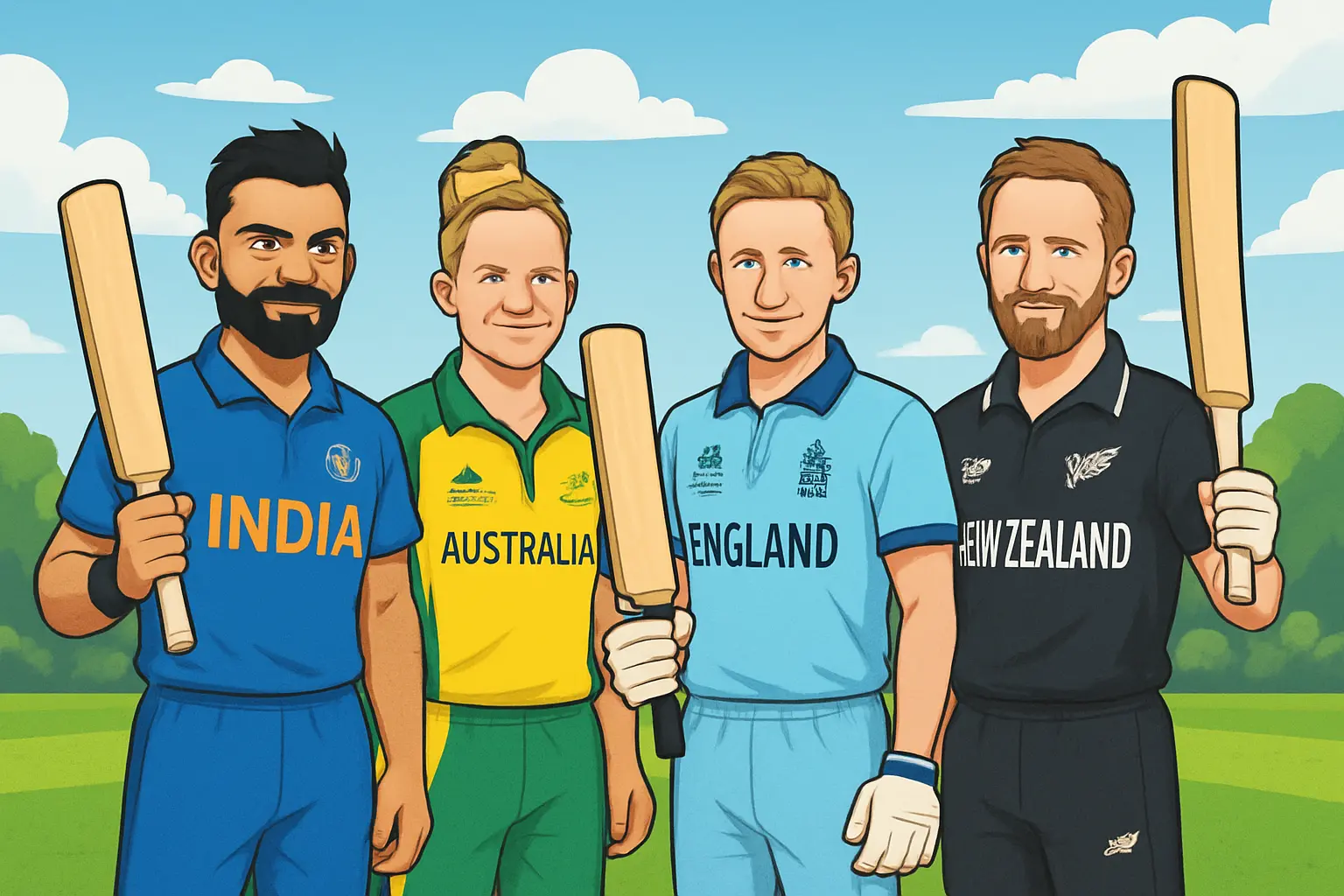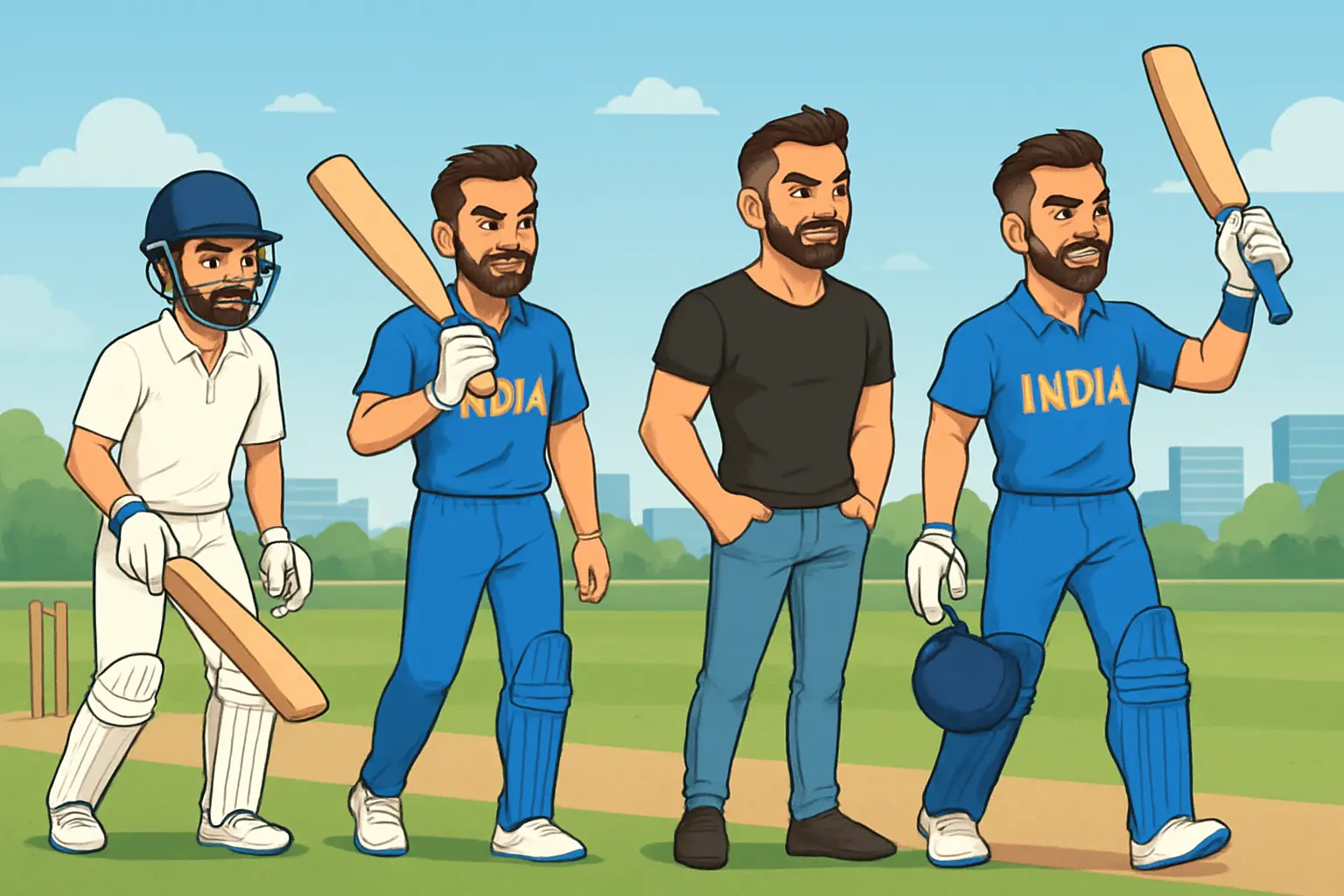The ownership story of the league has always been more than signatures on share certificates. These ten franchises are backed by industrial giants, global investors, media barons, and Bollywood royalty. Together they form a financial and cultural spine that keeps the tournament humming through auctions, packed stadiums, and endless debate on team strategy. Below is the current, authoritative landscape of IPL team owners, including the companies behind each franchise, reported stake splits where public, and the context that matters.
IPL team owners at a glance
| Team | Primary owner(s) | Operating company | Reported stake | Since | Notes |
|---|---|---|---|---|---|
| Chennai Super Kings (CSK) | Promoter group led by N. Srinivasan | Chennai Super Kings Cricket Limited (CSKCL) | Majority promoter control | Since demerger from India Cements structure | Legacy link to India Cements; among the most stable ownerships |
| Mumbai Indians (MI) | Reliance Industries family (Nita Ambani, Akash Ambani as public faces) | Indiawin Sports Pvt Ltd (Reliance Group) | 100% via Indiawin | Since inception | Flagship global multi-team brand under MI umbrella |
| Royal Challengers Bangalore (RCB) | United Spirits Limited (Diageo) | Royal Challengers Sports Pvt Ltd (RCSPL) | 100% via USL | Since transfer from initial promoter group | Corporate-owned, strong consumer brand synergy (beverage portfolio) |
| Kolkata Knight Riders (KKR) | Red Chillies Entertainment & Mehta Group | Knight Riders Sports Pvt Ltd | Joint venture | Since inception | Co-promoted by Shah Rukh Khan and Juhi Chawla–Jay Mehta |
| Rajasthan Royals (RR) | Emerging Media (Manoj Badale) with RedBird Capital Partners and other partners | Royal Multisport Pvt Ltd | Majority consortium led by Emerging Media | Since reinstatement | Known for data-led scouting and youth pathways |
| Sunrisers Hyderabad (SRH) | Kalanithi Maran family | Sun TV Network Ltd | 100% Sun TV | Since franchise acquisition | Clear owner identity and strong regional media muscle |
| Delhi Capitals (DC) | JSW Group and GMR Group | JSW GMR Cricket Pvt Ltd | 50:50 joint venture | Since rebrand and JV formation | Two-promoter model with active sports operations arms |
| Lucknow Super Giants (LSG) | RPSG Group (Sanjiv Goenka) | RPSG Sports Pvt Ltd | 100% via RPSG | Since expansion | Diversified sports portfolio and robust high-performance set-up |
| Gujarat Titans (GT) | CVC Capital Partners | Irelia Company Pte Ltd (CVC fund vehicle) | 100% via CVC fund entity | Since expansion | Private equity-owned; due diligence spotlight at entry |
| Punjab Kings (PBKS) | Mohit Burman (Dabur), Ness Wadia (Bombay Dyeing), Preity G Zinta, Karan Paul (Apeejay Surrendra) | KPH Dream Cricket Pvt Ltd | Reported split: Mohit Burman group ~46%, Ness Wadia ~23%, Preity Zinta ~23%, Karan Paul ~8% | Since inception | Bollywood presence plus diversified business groups |
Owner of CSK — Chennai Super Kings
CSK is owned by Chennai Super Kings Cricket Limited, a standalone entity that emerged out of the India Cements ecosystem and remains promoted by N. Srinivasan. The core is a business run like a durable institution: steady leadership, strong governance, and a fan-first philosophy centered on continuity.
The ownership has a unique advantage: institutional memory. Decisions are rarely knee-jerk. Coaches, analysts, and senior players are backed through cycles. Retention strategy reflects a cement-company mindset—long-term projects, not quarterly blips. That’s why the brand rides on trusted faces and process stability, visible in how the franchise stays calm through injury storms and form dips. Even when the auction dynamics force churn, CSK’s backroom, including their scouting cells and academy pipeline, identifies role-fit cricketers who accept clearly defined tactical jobs.
Sponsorship pull is elite. The yellow shirt is among the most coveted surfaces in Indian sport for brands aiming to cut through the noise. Commercial deals are supported by an ardent South India fan base and a diaspora that travels and spends. CSKCL also invests in grassroots and academies, extending the brand beyond the season and building a moat that feels wider with each campaign.
Owner of MI — Mumbai Indians
MI is owned by Indiawin Sports, a Reliance Industries subsidiary, with Nita Ambani and Akash Ambani as the public faces. This is not a team; it’s a sports platform. The MI umbrella stretches across multiple leagues worldwide, giving the scouting department global reach and a deep talent marketplace to test, train, and transfer ideas.
The ownership’s competitive edge lies in professionalization. Dedicated analytics and scouting—spearheaded earlier by people like John Wright and later a robust multi-scout network—have historically uncovered domestic value years ahead of rival bids. MI’s approach to role specialization, defined by powerplay matchups, death-overs clarity, and left-right batting balancing, reads like a best-practices manual for T20 league management.
Commercially, MI commands top-tier brand recognition in India and abroad. The franchise runs like a consumer brand, from its visual identity to its content machine, ensuring that even transitional phases keep fans engaged and sponsors satisfied. The training environments are benchmarked against elite global sport, with sports science and performance data feeding decision loops in-season and off-season. When the owners show up at auctions, they drive the room’s tempo, and rivals watch their paddles closely.
Owner of RCB — Royal Challengers Bangalore
RCB is owned by United Spirits Limited (USL), part of the Diageo group, via Royal Challengers Sports Pvt Ltd. The franchise originally carried the glam imprint of Vijay Mallya’s UB Group; over time, USL shifted the club toward corporate governance with clearer compliance, budgeting discipline, and brand synergy aligned with USL’s beverage portfolio.
Under USL, RCB matured into a content-first powerhouse. Few teams have built as loyal a community without a trophy cabinet telling the story. The 12th Man Army is an always-on audience, monetized and nurtured through social content, memberships, and experiential marketing. On the cricket side, RCB’s rise has coincided with smarter auction tables, embracing death-overs specialists, powerplay wicket-takers, and lower-order finishing—areas that were earlier soft.
Strong brand ambassadors and global superstars lift valuations, but the real ownership win is the lifestyle brand that sits on top of the cricket team: merchandise lines, music tie-ins, watch parties, and a near-permanent presence on Indian social timelines. Under a corporate owner like USL, decisions are audited as rigorously as any consumer product launch.
Owner of KKR — Kolkata Knight Riders
KKR sits under Knight Riders Sports Pvt Ltd, jointly promoted by Red Chillies Entertainment and the Mehta Group. Shah Rukh Khan’s charisma gave KKR a pop-culture base from day one, but the ownership’s real value is Venky Mysore’s professional sports administration blended with film-industry publicity craft. The franchise’s global sprawl now includes teams in the Caribbean, UAE, and the United States, creating a knowledge and player movement network that mimics European football multi-club models.
KKR leaned early into data science and domestic talent development. That early fascination with matchups, wrist-spin value, and impact-substitutions has shaped how rival analysts think. The academy networks and coaching appointments reflect an analytical bias—one that still allows for instinct when a young Indian quick, a mystery spinner, or a fearless finisher looks ready. Commercially, KKR’s purple has the swagger of Bollywood while maintaining boardroom composure, balancing glitz with bottom-line sense.
Owner of RR — Rajasthan Royals
Rajasthan Royals is controlled by a consortium led by Emerging Media (Manoj Badale), with strategic investment from RedBird Capital Partners and other partners including Lachlan Murdoch. The Royals have always played a different moneyball. They were the first to make a virtue of undervalued assets: late bloomers, domestic capless gems, and flexible role players. That identity isn’t a one-off underdog story; it’s an ownership doctrine.
The ownership invested in scouting and player development structures that outlive individual seasons. Academies and high-performance ties in India and overseas feed into trials and early onboarding. Royals content keeps their “pathway” positioning front and center, with stories of domestic names being nurtured long before they become household. RedBird’s presence brings professional sports experience across several global properties, and the consortium model allows capital depth without diluting the club’s challenger spirit.
Rajasthan’s sponsorship portfolio skews toward partners happy to be part of a clever, modern brand rather than a celebrity caravan. The outcome is a club that wins hearts with transparent processes: if you are a teen cricketer in India, you learn quickly that Royals scouts might actually be watching your district finals.
Owner of SRH — Sunrisers Hyderabad
Sunrisers Hyderabad is owned by the Maran family via Sun TV Network. Broadcast expertise influences everything: content cadence, sponsor packaging, and regional fan activation. The presence of Kaviya Maran at auctions and on match days symbolizes more than face value. It signals an owner deeply invested in sporting calls.
The SRH identity historically rests on bowling. Ownership backed decision-makers who built attacks worthy of low-scoring thrillers and slow-track mastery. That bias required courage in auctions where batters grab headlines. Though there have been moments when decision-making drew scrutiny—leadership handovers and high-profile player-management tensions—the franchise retains a reputation for assembling serious bowling units that travel well in Indian conditions.
Commercial deals tap South India’s deep TV roots, and local community initiatives keep the brand tied to the region’s cricket nurseries. SRH’s best seasons have reflected a top-down clarity: let bowling win tournaments and let batting be functional with a couple of game-breakers. The owner’s media DNA fits that philosophy—tight scripts, sharp plotting, and efficient execution.
Owner of DC — Delhi Capitals
Delhi Capitals is co-owned by JSW Sports and GMR Sports, formalized under JSW GMR Cricket Pvt Ltd with an even split. This two-promoter structure is unusual and, when it hums, incredibly powerful. JSW brings aggressive sports management and high-performance systems from its Olympic programs; GMR offers stadium expertise, event operations, and a legacy of running the original Delhi franchise.
The rebrand gave the team a cleaner identity and a fresh operating rhythm. Management invested in academies, regional scouting tournaments, and age-group pathways. JSW’s sports-science lean permeates training: centralized performance data, injury prevention protocols, and role clarity that bleeds into auction priorities. When Delhi is at its best, you see a blend that looks like modern T20 thinking: top-order intent, spin matchups, and athletic fielding standards.
Commercially, Delhi stands strong in the national capital region with sponsorships that fit a metropolitan brand. The JV has navigated the delicate dance of shared decision rights, and the result is a series of measured roster builds that don’t panic with form swings.
Owner of LSG — Lucknow Super Giants
Lucknow Super Giants is owned by the RPSG Group under Sanjiv Goenka through RPSG Sports. The group arrived in this cycle with intent and a template: boardroom discipline, a sports portfolio that includes football, and a belief in process that mirrors their power and retail businesses.
LSG invested quickly in infrastructure and analytics. The franchise’s cricket operations lean into matchup modeling, batting-depth philosophies, and death-overs contingency plans. RPSG’s previous experience with a temporary franchise in the league gave them practical lessons on auction tables and leadership structures, and those cues show in squad architecture.
The brand plays well in the Hindi heartland, supported by community events and regional partnerships. RPSG runs crisp sponsor integrations and builds category exclusivity with a long-term lens, not year-to-year churn. Player care and sports science have been visible strengths, with a backroom that focuses on reducing availability risk and building redundant roles for the slog overs.
Owner of GT — Gujarat Titans
Gujarat Titans is owned by a fund vehicle of CVC Capital Partners, Irelia Company Pte Ltd. Entry came with heightened due diligence given CVC’s broader portfolio, but the franchise settled into operations with a sharp sporting identity almost immediately: disciplined bowling plans, clear powerplay intent, and a management group that communicates simply.
Private equity ownership brings a different cadence. Financial controls are tight, governance is documented, and performance metrics extend beyond the scoreboard into content consumption, sponsor activation ROI, and fanbase growth. On the cricket side, the Titans embraced the modern T20 archetype: multi-skill players, calm leadership, and flexible batting orders. The backroom built a stable dressing room by choosing personalities that mesh, reducing volatility when pressure peaks.
Commercially, GT came out of the blocks with smart partnerships and a visual identity that turned heads without trying too hard. In auctions, the franchise behaves like a team with a spreadsheet but also a feel for locker-room chemistry—a rare blend in the league’s high-noise environment.
Owner of PBKS — Punjab Kings
Punjab Kings is owned by KPH Dream Cricket Pvt Ltd, a consortium of Mohit Burman of the Dabur family, Ness Wadia of Bombay Dyeing, actor-producer Preity G Zinta, and Karan Paul of the Apeejay Surrendra Group. The reported shareholding split commonly cited is approximately 46% for the Burman group, 23% each for Wadia and Zinta, and 8% for Paul. The star factor remains central to the brand’s public image, with Preity Zinta’s presence in stadiums and auctions offering a direct emotional wire to fans.
PBKS has lived vivid cricketing lives: thrilling chases, heartbreaks at the line, seasons of sumptuous batting and frustrating inconsistency. A frequent coaching and leadership carousel suggests internal appetite for quick fixes, but there’s a notable shift toward stability whenever the front office finds alignment between captain, coach, and analyst. Sponsorships remain robust thanks to the franchise’s pan-India pull and the owners’ business networks.
The ownership’s challenge has always been translating intent into a coherent team identity. When PBKS gets that right—balanced bowling stocks, disciplined middle overs, and powerful finishing—their ceiling touches the title picture. The owners’ continued investment in domestic scouting and facility upgrades indicates a long view that could turn the page on volatility.
How IPL team ownership actually works
- Franchise rights: Teams buy franchise rights from the league and pay a contracted fee over a defined period. New entrants agree to the fee structure in auction-style bidding; legacy teams came in at base franchise prices set by the league. Ownership is granted to a corporate entity, often a special purpose vehicle.
- Central revenue: The league pools media rights and central sponsorships. A fixed share is distributed equally among franchises, with a performance component linked to finishing position. Owners factor this predictable revenue when budgeting for salaries, staff, and operations.
- Local revenue: Ticketing, in-stadium advertising, local sponsorships, hospitality, merchandising, and licensing roll up into the club’s P&L. Owners push stadium experience—sound, light, fan zones—because every extra body through the turnstiles helps both direct revenue and future sponsor negotiations.
- Salary cap: Teams operate under a hard player salary cap set by the league. Rich owners cannot simply outspend rivals on player salaries, which protects competitive balance and keeps the focus on strategy, scouting, and development.
- Player trading and releases: Owners sign off on trades, retentions, and releases. Retained players hit the cap differently than newly signed ones; savvy owners use cap geometry to front-load or back-load squads depending on auction archetype.
- Governance and compliance: Owners must meet fit-and-proper criteria and uphold league regulations around anti-corruption, betting conflicts, and financial disclosures. Many appoint independent directors or advisors to keep oversight sharp.
Ownership changes and inflection points
- Corporate to corporate: RCB’s move from a flamboyant promoter-driven ownership to USL’s disciplined corporate-run model marks a major governance shift in league history. It professionalized operations and re-shaped brand positioning without dimming fan appeal.
- Demerger and independence: CSK’s shift from India Cements’ direct fold to a dedicated company built a more transparent sporting enterprise while maintaining promoter continuity.
- Broadcast power to franchise power: SRH’s acquisition by Sun TV consolidated a strong regional media voice inside the league’s ownership circle and amplified the franchise’s commercial heft.
- Joint venture sophistication: DC’s 50:50 JSW-GMR structure shows how two heavyweights can co-exist sensibly when responsibilities are carved out and a rebrand resets culture.
- Private equity era: GT’s ownership by CVC Capital Partners underlines the league’s attractiveness to global capital, with PE bringing structured decision-making and performance frameworks found in European football and American sports.
- Consortium dynamics: RR’s Emerging Media consortium, strengthened by RedBird’s entry, exemplifies a modern blend—founder-led vision plus institutional sports investors who respect on-ground expertise.
The money, the valuations, and the pecking order
- Media rights trajectory: Every central rights cycle has transformed revenue curves, increasing equal-share distributions, and raising base valuations. Teams now model multi-season cash flows with more confidence.
- Brand monetization: Merchandise velocity, content reach, and digital memberships lift both top-line and sponsor pricing power. MI and CSK often sit at the top of brand value rankings, with KKR and RCB close on overall commercial momentum.
- City economics: Market size matters—Mumbai and Delhi provide deep sponsor markets and higher hospitality potential. But well-run brands in smaller markets punch above weight by owning their city’s identity and building community-led loyalty.
- Owner net worth vs. team valuation: Reliance-backed MI and CVC-backed GT indicate the league’s magnetic pull for serious capital. RPSG, JSW, GMR, and Sun TV are also equipped for sustained investment. Bollywood-backed or consortium-led clubs find different advantages—reach, cultural capital, and flexibility.
- Long-term upside: Global multi-club portfolios, academies that produce saleable talent, and women’s team expansions all contribute to long-range valuations that push beyond a single men’s season.
Controversies and governance guardrails
The league has had its share of turbulence. Ownerships have been stress-tested by match-fixing headlines, conflicts of interest, and due diligence questions. Two franchises served suspensions in the past, and one new entrant faced intense scrutiny around past fund investments before receiving clearance. The system learned and tightened: better anti-corruption frameworks, more transparency around beneficial ownership, and stricter bidding protocols.
Clubs have also navigated internal storms—coaching overhauls, captaincy flashpoints, and auction misfires. The best ownerships show restraint, absorb the bad press, and fix systems instead of scapegoating players. Stability correlates strongly with on-field consistency in a cap-locked league.
Owner-by-owner deep dive: strategy, scouting, and brand building
Chennai Super Kings (CSK)
- Ownership thesis: Continuity. The front office treats the team like a durable manufacturing operation—reliable inputs, refined processes, quality control. The captain-coach axis stays intact over long cycles, and role clarity keeps a wide squad engaged.
- Scouting and recruitment: Emphasis on temperament and role fit. Unflashy domestic pros often become cult heroes because they fit clear tactical slots: middle-overs control, death-overs resourcefulness, and spin-friendly batting options.
- Commercial engine: A pan-India yellow wave with serious depth in South India. Sponsor retention is high; partners view CSK as a low-volatility asset.
Mumbai Indians (MI)
- Ownership thesis: Professionalization and scale. MI operates like a global sports holding company, creating cross-league synergies in scouting and performance science.
- Scouting and recruitment: Early bets on uncapped Indian pace, boundary-hitting allrounders, and highly specific bowling roles. Data complements the experienced eye test—especially in projecting future value for youngsters.
- Commercial engine: High-gloss content, celebrity adjacency, and a city with deep corporate pockets. MI merchandise and partner activations are league-leading.
Royal Challengers Bangalore (RCB)
- Ownership thesis: Corporate discipline meets pop-culture magnetism. USL’s systems have cleaned and sharpened operations, aligning them with the world’s best consumer brands.
- Scouting and recruitment: A clear pivot to balance—wicket-taking pace, death-overs skills, and finishing muscle to support iconic top-order names. Analytics focus on winning moments rather than aggregate stat-chasing.
- Commercial engine: A lifestyle brand built on a loud, loyal community. RCB’s digital footprint converts to partner value even in years when the table finish doesn’t flatter.
Kolkata Knight Riders (KKR)
- Ownership thesis: Entertainment power fused with analytical rigor. Celebrity gravity opens doors; rigorous sports admin keeps the engine steady.
- Scouting and recruitment: Comfort with unconventional picks—mystery spin, high-variance hitters, flexible utility players. The global Knight Riders ecosystem allows knowledge recycling and player movement.
- Commercial engine: Regional pride with national and international reach. KKR sells the romance of purple and gold while delivering value-packed sponsor options.
Rajasthan Royals (RR)
- Ownership thesis: Moneyball with heart. The Royals double down on undervalued assets and pathway narratives, empowering a scouting network that never sleeps.
- Scouting and recruitment: Academy-fed pipeline, early identification of multi-skill players, and a willingness to give leadership to young Indian talent.
- Commercial engine: Challenger brand appeal. Sponsors appreciate the authenticity and innovation; fans love the “we’ll find a way” energy.
Sunrisers Hyderabad (SRH)
- Ownership thesis: Media-grade efficiency. SRH leans into clarity and coordination, often using bowling-first logic to build title-capable structures.
- Scouting and recruitment: Pace and spin attack depth with smart, low-noise batting additions. Auction tables reflect a plan that’s hard to see until the season begins—and then it clicks.
- Commercial engine: South Indian broadcast powerhouses know how to package and distribute content; SRH benefits from that core competence.
Delhi Capitals (DC)
- Ownership thesis: Dual-power balance. The JSW-GMR JV fuses high-performance obsession and stadium/event operations experience.
- Scouting and recruitment: Balanced roster construction with an eye for tempo batters, gun fielders, and bowlers who can operate in Delhi’s specific conditions.
- Commercial engine: The capital’s corporate density helps. Clean branding and resilient partnerships create predictability in revenues.
Lucknow Super Giants (LSG)
- Ownership thesis: Structured excellence. RPSG’s sports blueprint emphasizes infrastructure, analytics, and medical excellence—replicated from its broader business culture.
- Scouting and recruitment: Matchup and role depth with redundancy in critical skill sets. Auction moves often look measured, avoiding overpayment spirals.
- Commercial engine: Regional resonance with nationwide polish. LSG speaks clearly to its heartland while offering national-level activation canvases.
Gujarat Titans (GT)
- Ownership thesis: PE precision with sporting humility. CVC’s standards meet a dressing room that values calm, clarity, and cohesion.
- Scouting and recruitment: Multi-skill cricketers who can absorb pressure, deep bowling smarts, and a leadership group that keeps messages simple.
- Commercial engine: Fresh brand energy supported by professional sponsorship sales and neat content packaging.
Punjab Kings (PBKS)
- Ownership thesis: Passion plus persistence. The consortium blends Bollywood connection, consumer brand networks, and old-guard enterprise.
- Scouting and recruitment: When aligned, PBKS drafts squads with scary batting upside and increasingly disciplined bowling mixes.
- Commercial engine: Big reach and a joyful visual identity. Advertisers love the punchy red; fans love the drama. The job now is to turn resonance into ruthlessness.
Stake percentages, where they matter
- Delhi Capitals: A clean 50:50 JV split between JSW Sports and GMR Sports under JSW GMR Cricket Pvt Ltd.
- Mumbai Indians: Fully held through Indiawin Sports, a Reliance subsidiary.
- Royal Challengers Bangalore: Fully controlled by United Spirits Limited via RCSPL.
- Sunrisers Hyderabad: Fully owned by Sun TV Network.
- Lucknow Super Giants: Fully owned by RPSG Group through RPSG Sports.
- Gujarat Titans: Fully controlled by a CVC Capital Partners fund vehicle (Irelia Company Pte Ltd).
- Punjab Kings: Widely reported consortium split with the Burman group as largest shareholder; specific percentages for other partners commonly cited but remain “reported” rather than officially detailed on public exchanges.
- Chennai Super Kings and Kolkata Knight Riders: Ownership sits within dedicated companies with promoter groups holding majority control; public market-style breakdowns are not regularly disclosed in granular terms. KKR remains a Red Chillies–Mehta JV; CSK remains under CSKCL promoted by N. Srinivasan.
How owners turn a profit
- Central distributions cover a significant portion of operating costs. As media rights rise, the equal-share component increases baseline financial health, making even mid-table finishes economically robust.
- Ticketing and hospitality can transform matchdays into profit centers, especially in cities with corporate hospitality demand.
- Category-exclusive sponsorships and growing digital inventory sell well when teams control a strong narrative throughout the year.
- Merchandise spikes when star players peak and when content keeps stories fresh. Owners invest in design and limited drops to lift per-capita spend.
- Multi-club ownership enables cost efficiencies in scouting, coaching, and medical infrastructure. Shared services reduce overheads per team.
- Women’s cricket, academies, and global franchise tie-ins add future revenue layers and boost enterprise valuation.
Richest owners vs. most valuable teams
Richest is not the same as most valuable. A global conglomerate like Reliance lifts MI’s institutional stability and access to capital, but CSK’s on-field consistency and fan devotion often push their standalone brand value to the top. KKR’s celebrity hook gives them unique pricing power in content and merchandising. RCB’s community effect—memes, music, meetups—turns engagement into sponsor gold. GT and LSG reflect the new money era, with professional-grade ownership frameworks that scale quickly. Meanwhile, SRH and DC, backed by substantial enterprise groups, can be conservative or aggressive without fearing short-term cash crunches.
The future of IPL ownership
- Deeper analytics and AI: Owners will invest in proprietary models that track form, fatigue, and tactical utility beyond public stats. The edge shifts from who has data to who asks better questions of it.
- Multi-club ecosystems: More cross-league player development, loan systems (where allowed), and staff exchanges will create year-round pipelines.
- Stadium upgrades: Owners will push for improved fan experience—seating, F&B, and tech integration—to keep stadiums competitive with living room setups.
- Sustainability: ESG screens will enter franchise decks, affecting sponsorship portfolios and stadium operations. Expect energy-efficient venues and responsible waste management to be part of owner communications.
- Women’s cricket: A parallel franchise ecosystem will grow into a second pillar, with sponsorships and media value standing on their own rather than as add-ons.
Team-by-team owner profiles in one breath
- CSK: Chennai Super Kings Cricket Limited; promoter N. Srinivasan; legacy ties to India Cements; stability as strategy.
- MI: Indiawin Sports under Reliance; a global sports platform mindset; elite scouting; premium brand.
- RCB: United Spirits Limited via RCSPL; corporate governance; community-first lifestyle brand.
- KKR: Knight Riders Sports; Red Chillies and Mehta Group; celebrity-powered, analytics-driven, multi-league network.
- RR: Emerging Media-led consortium with RedBird; pathway and data obsession; underdog spirit institutionalized.
- SRH: Sun TV Network; broadcast-smart ownership; bowling-first DNA.
- DC: JSW-GMR 50:50 JV; high-performance systems; capital-city commercial base.
- LSG: RPSG Sports; infrastructure and analytics; heartland resonance with national polish.
- GT: CVC Capital Partners via fund vehicle; PE-grade governance; calm, cohesive cricketing identity.
- PBKS: KPH Dream Cricket consortium; big personality and widespread reach; turning passion into consistent results.
Owner presence at auctions and behind-the-scenes dynamics
Walk the auction floor and ownership styles reveal themselves. MI and CSK sit with pre-baked scenarios and near-telepathic communication lines between owner reps, coaches, and analysts. KKR and RR take more calculated swings on “ceiling” players, comfortable living with variance. RCB’s table has grown increasingly pragmatic, prioritizing bowling resources in the same breath as marquee batters. DC plays the long game, often waiting out bidding wars to collect value late. SRH, LSG, and GT signal clarity through targeted bids and minimal drama. PBKS can be aggressive early, with the room buzzing when their paddles rise.
Owners also set tone in the dressing room by who they hire to lead. Teams with stable heads of cricket and empowered analysts rarely go out of shape. Medical and S&C staff matter too—owners willing to spend on rehab tech and recovery cycles see fewer availability crises in crunch time.
What sets an outstanding owner apart
- Clarity of philosophy: T20 is chaos; philosophy is the anchor. Owners who define it and stay consistent through form dips create resilient organizations.
- Empowerment: Hire well, then get out of the way. Micro-management rarely survives a tournament this volatile.
- Patience with young talent: Domestic stars are not minted in a fortnight. Owners who give runway reap value both on-field and in the cap table.
- Communication: Fans read silence as apathy. The best owners are present without being overbearing, visible without stealing the story.
- Investment in people: Analyst retention, coach development, and sports science capacity are compounding advantages that separate champions from contenders.
Common myths about IPL ownership, corrected
- Rich owners automatically win: The salary cap and auction system limit chequebook dominance. Smart strategy beats raw spend.
- Celebrity ownership is just marketing: It drives tangible commercial value, froths merchandise, and opens doors for sponsors. When matched with strong operations, it’s a force multiplier.
- Mid-market cities handicap revenue: A fierce regional identity can outperform a lukewarm big-city base in impact and loyalty metrics.
A compact reference list for quick answers
- Owner of CSK: Chennai Super Kings Cricket Limited (promoter N. Srinivasan; legacy link to India Cements)
- Owner of MI: Indiawin Sports Private Limited (Reliance Group; Nita and Akash Ambani as public faces)
- Owner of RCB: United Spirits Limited via Royal Challengers Sports Pvt Ltd
- Owner of KKR: Knight Riders Sports Pvt Ltd (Red Chillies Entertainment and Mehta Group)
- Owner of RR: Emerging Media-led consortium with RedBird Capital Partners and others
- Owner of SRH: Sun TV Network (Maran family)
- Owner of DC: JSW GMR Cricket Pvt Ltd (50:50 JSW and GMR)
- Owner of LSG: RPSG Sports Pvt Ltd (RPSG Group; Sanjiv Goenka)
- Owner of GT: Irelia Company Pte Ltd (CVC Capital Partners fund vehicle)
- Owner of PBKS: KPH Dream Cricket Pvt Ltd (Mohit Burman, Ness Wadia, Preity Zinta, Karan Paul; reported split with Burman group largest)
What fans should watch for next
- Owners aligning with global T20 ecosystems, enabling loan-like arrangements and knowledge transfer.
- Continued professionalization of front offices, with analysts and S&C heads becoming as influential as assistant coaches.
- Expansion of academy networks, especially in Tier-2 and Tier-3 cities, as owners compete for the next domestic superstar pipeline.
- Evolving revenue models where digital memberships and OTT content subscriptions become meaningful P&L lines for franchises.
Final word
The league’s owners form a mosaic of Indian enterprise and global capital. Cement and steel. Media and movies. Private equity and family-run legacies. When the season begins, the scoreboard tells only part of the story. The rest unfolds in auction rooms, medical bays, scouting diaries, and board meetings where visions are argued into shape. The great owners know that winning here is an operating philosophy, not an event. They build systems that survive lean seasons, elevate people who think clearly under lights, and set standards the rest chase.
If you came looking for a single line answer to who owns each IPL team, you have it. If you came to understand how ownership shapes every last over, you now know the levers and the logic. In this league, the smartest money is the money that sees the game whole—and stays humble enough to keep learning.








